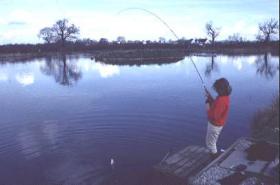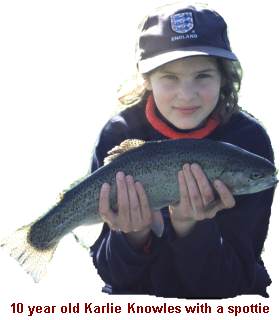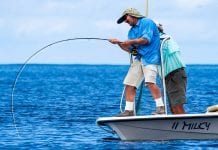Okay so that’s a sweeping statement and in reality it is probably far from the truth. If my experiences of trying to catch little wild brownies from the crystal clear streams of North Wales are anything to go by, you need a hell of a lot more skill with the fly rod than I posses to be successful. 

But there is another side to the noble art of fly-fishing. A much more accommodating quarry is there to be had. Bigger, fatter and infinitely more stupid than our native brown trout the Rainbow Trout has been stocked in a multitude of stillwaters all over the country. These waters vary from muddy holes in the ground, crystal clear weed strew pools and even huge reservoirs amounting to hundreds of acres. Most people, maybe without even realising it, will have such a water within an short drive from home. Day tickets are the norm so don’t think for one minute that there is anything ‘exclusive’ about fly fishing. Also forget the idea that there is something terribly difficult about casting a fly, twenty minutes practice in the nearest field with a rod and line is usually enough (if you can put up with the local kids shouting ‘Caught anything mister’? Before collapsing into a heap of laughter). Okay perhaps you won’t be able to drop a dry fly right on the head of a rising brownie but it is probably long enough to have you chucking the 20 yards or so that is necessary on a stillwater.
Still not convinced? Okay I’ll give you an example. Last May I took my eldest daughter, Karlie, for a day’s ‘spotty bashing’, she was at the time all of 10 years old and she had just an hour or so practising her casting technique the evening before.
We had chosen a well-run and well-stocked Trout fishery in Cheshire, Meadow Fishery, and bought a single ticket as I did not intend to fish. I tied on my favourite early season lure, a green and white Cat’s Whisker and away she went. After about twenty minutes of thrashing the water, with constant encouragement and by ignoring the sniggering of the so called experts (who should know better) she began to get into a bit of a rhythm and was soon casting competently around 10-15 yards out, which, for most small waters, is more than adequate. Suddenly, as she was retrieving, something pulled back, she panicked, held firm and a resounding crack was heard as the 6lb leader was snapped like cotton – they do pull back these rainbows!
Undaunted by this and spurred on by the action we retied the leader and repeated the process. This time the plan was that upon hooking a fish she would wind like mad to take all the slack line back onto the reel then play the fish using the ratchet. The second take came a few casts later and she proceeded to wind for all she was worth……..in the wrong direction. The resulting birds nest made me smile as it brought back many happy memories of passing my own rod to my father on numerous occasions to undo tangles of similar proportions. Anyway I soon had the line back on the reel and incredibly the fish was still attached. As she still hadn’t quite grasped when to retrieve line and when to give some back I would tap her lightly on the arm every time I wanted her to let go of the reel handle. Upon this signal she let go of the reel and the rainbow would make a dash for freedom the ratchet screaming on each run with a very pleasing sound. It took a little longer then usual to subdue the unfortunate stockie but soon he was lying on the grassy bank with Karlie dancing a little jig of celebration, much to my amusement.
Once she had landed the first one there was no stopping her, soon around half a dozen fish had been hooked, landed and released with Karlie laughing and giggling with every fish hooked. 

Then it happened, the highlight of the day. One of the local ‘experts’ confounded at his total lack of success had slowly made his way around to the next peg in an attempt to get his first take (perhaps if he had fished into the wind like us he would have had some action!). He sauntered across, complete with floppy hat and chest waders – even though fishing was from the platforms only! – and said to Karlie. ‘Excuse me dear but would you mind telling me what pattern fly you are using with such success.’
Karlie looked at me to see if she should answer this strange looking amphibian. I nodded for her to speak.
‘I don’t know, it’s just a big fluffy thing my dad gave me.’ She replied, smiling sweetly.
Now I know I shouldn’t have, but I couldn’t help it, I collapsed to the floor howling with laughter whilst ‘Mr Barbour’ walked away shaking his head as he departed.
Now I’m sure this guy was a much better fly angler than my daughter, probably than I was also, but he had made one very basic mistake. Rainbows will always follow the wind. It may be harder casting and more uncomfortable than getting the wind on your back but the difference in catch rates is usually staggering. In my opinion, the fly pattern on a stockie water is largely irrelevant. You need to pull something in front of a hungry rainbow’s nose and he will take it. Hence, as with most forms of fishing the key to success is location. Once you have found where the majority of fish are holed up you will undoubtedly get action.
Again this is a bit of a sweeping statement but don’t forget I’m talking here of recently introduced stock fish. They have no concept of danger; and usually the first mistake they make is their last. Quite often they will go from pellet feed to lure to frying pan within a day. On the other hand once a rainbow has been in the water a while, caught and subsequently released, it becomes an entirely different prospect. Wising up pretty quickly and suddenly becoming much more of a challenge. With this in mind for your first trip I would find a water that has a fast turnaround of fish, that way your first session will be a confidence booster. Check the catch returns of the fishery before you buy a ticket and look for one that has an average of at least 5-6 fish per rod, preferably more.
Okay, lets assume I’ve convinced you to have a go, what kit do you need to start?
A fly rod, a fly reel and 2 spools, one with floating line one with sinking. That’s pretty much it, apart from the flies themselves. Leaders (4-6lb), forceps and landing net can all be procured from your coarse gear. For the rod, reel and lines I would go into any of the larger tackle shops and tell them what you want. Most of them offer complete flyfishing packages at a discounted price. Conversely look in the mail order catalogues for a beginners kit, either way you can usually get a reasonable set up for under £ 50. Toddle along to your chosen fishery, buy a handful of flies and away you go.
Before you buy the flies stop and think for a minute. Don’t be tempted to buy the super looking damsels, crane fly’s or other realistic looking patters first. Likewise the tiny buzzers or nymphs that would look great in your new fly box – I did and they are all still there! Get yourself a selection Cat’s Whiskers, Tadpoles and Frizz’s. All these are gaudy looking lures and although an educated fish would look upon them with some disdain, a recently introduced stockie will chase the length of the lake to try and engulf it.
Once you start to fish remember these basics:
Fish into the wind – always ! You will catch far more fish in this way. The area of the lake facing the wind is usually empty anyway, as most people seem to prefer fewer fish but easier casting.
· Start with a sinking line, using a lure in the deepest part of the lake (especially early morning). This is where the big rainbows lie up waiting for the temperature in the upper layers of the water to increase.
· Start by using lures rather than tiny imitations, it may not be the most traditional way of landing rainbows but for a relative novice like me, it’s certainly the most successful.
· Do not lift your lure out until the retrieve is totally finished. I have lost count of the times a rainbow has made a desperate lunge at my lure when I have whipped it out of the water prematurely.
· As with coarse fishing don’t neglect the margins. Make your first couple of casts parallel to the bank. Quite often you will get an instant take off a predatory fish that is hunting sticklebacks or small fry.
· Enjoy yourself!
Let me just re-emphasise that in this very basic article I am talking about fishing for stocked rainbow trout on put-and-take fisheries. I fully accept that grown-on rainbows as well as wild brown trout and grayling are an entirely different proposition and as such would deserve a damn sight more respect and would not succumb to my crude methods. But in the coarse fish closed season I do enjoy a trip or two armed with just my fly rod and a pocket of fur and feather.
Make no mistake, on the soft action of a fly rod a rainbow trout, stockie or not, puts up a damn fine scrap and once you have experienced it you will be back for more.












